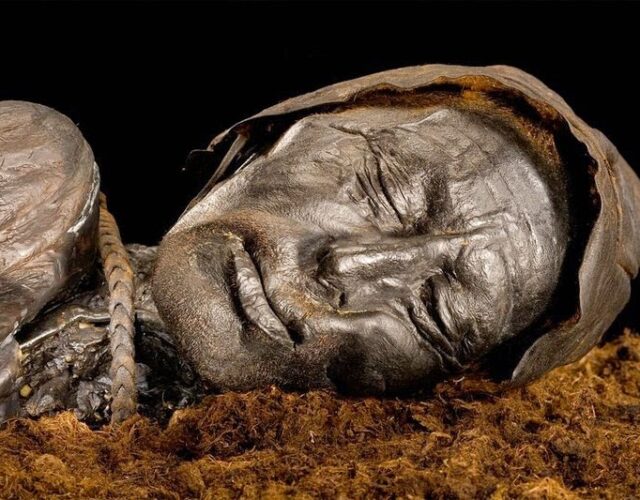At the end of the most recent ice age, around 11,000 years ago, melting ice formed a bog in North West England. Lindow Moss, as the bog came to be known, stretched for 1,500 acres across what is now the county of Cheshire, encompassing a mosaic of habitats: woodland, scrub, and mossland.
Today the picturesque bog lies on the outskirts of Wilmslow, a verdant town that once offered Victorian Manchester’s wealthy industrialists an escape from the city’s smoky haze. For the less well off, Lindow Moss had long offered a more spartan home. In the 15th and 16th centuries landless poor eked out a precarious living here on society’s margins, cutting and drying peat from the bog to sell as fuel for stoves and soil for crops. The industry continued well into the 20th century, operating much as it always had. Wor+kers would cut peat into blocks by hand and lay them in stacked rows to dry in the wan English sun, turning them repeatedly over a two-year period before they were ready for use.
But by the 1980s the Industrial Revolution had reached even this bucolic operation, and the whole process had been mechanized. Now peat is scooped up by mechanical diggers and placed in loose stacks, where it is left to dry. Afterward it is sent to a processing mill, checked for chunks of bark and branches large enough to jam the machinery, ground up into a fine compost, and then sold to mushroom growers around the country.
On May 13, 1983, Andy Mould and Stephen Dooley were standing by the mill’s conveyor, watching for anything that might foul the operations, when they spotted a lump that reminded Mould of a small, black leather soccer ball. “Perhaps,” they joked, “this is a dinosaur egg.” They pulled it off the belt and took it to Ken Harewood, manager of the peat works. Curious as to what the object might be, they washed it. But this was no ball. This was evidently, gruesomely, a human skull—missing its jaw but still possessing skin, some hair, and one baleful eyeball that stared at them.
The police were quick to respond to the grisly find. And in the best tradition of police work, they were quick to identify their suspect. For some time the constabulary had believed that a local man, Peter Reyn-Bardt, had murdered his wife. Problem was they didn’t have a body. They had fruitlessly dug over Reyn-Bardt’s garden, just 300 yards from the Lindow Moss. So when forensics reported the head was from a woman between 30 and 50 years old, the police were convinced.
Reyn-Bardt wasn’t hard to find. He had only recently been released from jail, having served time for a series of sex crimes against children. Confronted with news of the discovery in the bog, he quickly confessed. “It has been so long, I thought I would never be found out,” Reyn-Bardt told police under questioning.
In 1959 Reyn-Bardt, an airline employee, had married Malika Maria de Fernandez, a portrait artist who loved to travel. Their romance had been notable for its brevity—just hours from first meeting to proposal and then only four days until their wedding. Their union was similarly brief, lasting just a few months. Fernandez returned to traveling using her new husband’s discounted airfare while Reyn-Bardt settled into a cottage with a lover, a man.
Sometime in 1960 or 1961 Fernandez visited Reyn-Bardt at his cottage and demanded money, threatening to expose his sexuality if he didn’t pay. (Homosexuality remained a criminal act in England until 1967; the now infamous persecution and subsequent suicide of Alan Turing in the early 1950s would have been just one example of the risks facing gay men of that era.) Reyn-Bardt had no money to offer her, and the two fought.
“Something just boiled over inside me,” he stated in his confession. Later, while on trial, newspapers reported that he grabbed her shoulders and did not realize she was dead until he stopped shaking her. “I was terrified and could not think clearly. The only thing that came to mind was to hide her,” he told the court. He used an axe to dismember her remains, then tried to burn them. When that failed, he scattered them in the bog.
To the policeman in charge, Detective Inspector George Abbott, it seemed an open-and-shut case. The forensics showed a woman of the right age, and Reyn-Bardt had made a clear confession. But one issue nagged at Abbott: despite careful searching, the rest of Fernandez’s remains proved frustratingly elusive. Not satisfied, Abbott sent the head to Oxford University for further study.
The trial was conducted at the Chester Crown Court in December 1983. Reyn-Bardt sought to have his charge downgraded from murder to manslaughter. But then in a spectacular turnabout a professor from Oxford University’s archaeology department testified that the head could not possibly belong to Fernandez. Radiocarbon dating showed the remains were around 17 centuries old, dating all the way back to Roman Britain.
Reyn-Bardt tried to recant his confession but was convicted of murder by a jury count of 11 to 1. He spent the rest of his life in prison.
This sordid tale might have slipped away as just another gruesome historical anecdote. But a year later Andy Mould made a second morbid discovery in the peat. On August 1, 1984, standing again at the mill’s conveyor, Mould removed a piece of what he thought was bog wood. “We gave it a little clean, then we saw the toenails,” Mould said in a 2008 interview with the Manchester Museum.
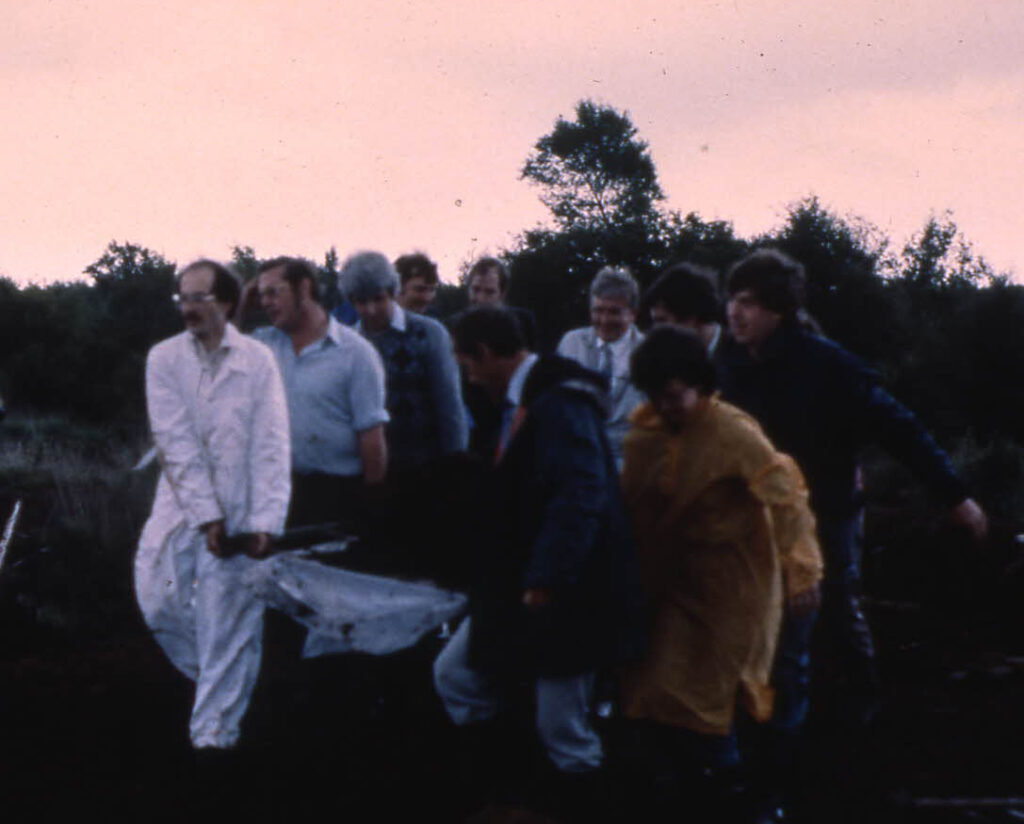
Workers remove the remains of Lindow Man from Lindow Moss, 1984.
Again the police were called. “They shut the firm down straight away,” said Mould, “and sent loads of officers to the site.” Given the recent court case and an ongoing search, they were faced with two main possibilities: either this leg was a missing piece of Malika de Fernandez, or it belonged to someone entirely different and possibly ancient.
That day, Rick Turner, county archaeologist for Cheshire, received a tip-off from the local paper about the find. The results of that tip would link his name to what became one of the most famous archaeological finds in British history: Lindow Man. And these remains in turn would wind up at the center of a scientific debate over a murder mystery nearly 2,000 years in the making.
The head and leg found at Lindow Moss are examples of increasingly well-known phenomena called bog bodies. Human remains have been turning up in the peat bogs of Denmark, the Netherlands, Ireland, the United Kingdom, northern Germany, and occasionally North America for hundreds of years.
These bodies can be amazingly well preserved. Even 8,000-year-old bog bodies can be in much better condition than the carefully prepared mummies of ancient Egypt. The famous Tollund Man of Denmark, for instance, could almost pass for an old man peacefully asleep, with a hat still on his head, whiskers on his chin—and a leather garrote around his neck.
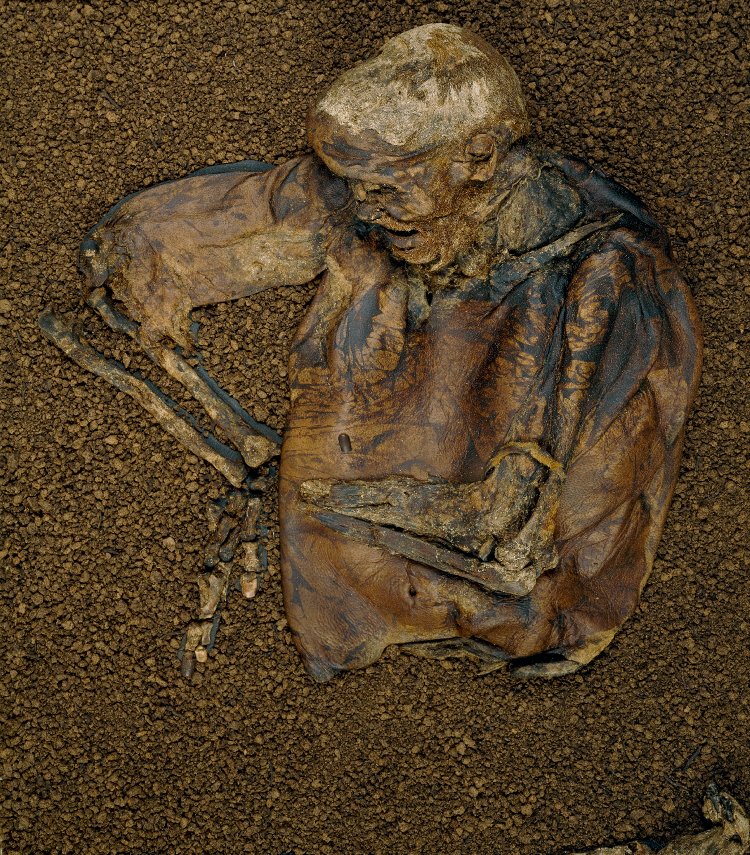
The remains of Lindow Man on display at the British Library.
Such preservation requires special conditions: a sphagnum moss bog with a temperature lower than 4°C (39°F) when the body is deposited and an average annual temperature lower than 10°C (50°F). And the bog must stay wet all year. The best-preserved bodies have been found in colder bogs, particularly those closer to the sea.
Sphagnum mosses change the chemistry of the bodies of water around them, making them highly acidic for a natural environment (a pH of roughly 3.3 to 4.5) and very low in dissolved minerals. As the floating mosses die, they build up layers at the bottom of the bog. The decaying mosses release sugars and humic acids into the water, which consume oxygen as they break down. With the surface blocked by the live moss, the water becomes anaerobic.
Under these conditions human tissues don’t decay. Instead they tan like leather. Skin turns brown, hair turns red, and objects in or around the body dissolve away, as does most clothing.
The first recorded bog body was found in 1640 at Schalkholz Fen in Germany. Since then hundreds of bodies have been found, primarily in northern Europe. They often display signs of violence and so are presumed to be murder victims. For centuries, after a body was discovered, it was most often given Christian reburial, and the remains rotted away. But by the 19th century there was greater interest taken in the scientific aspects of the phenomenon, though the techniques and methods of preservation of the bodies were limited. In 1871 German scientists attempted to smoke the remains of Rendswühren Man much as you would do to preserve a ham. It worked, but the resulting dehydration caused the body to shrink. In the early 1950s Danish researchers were able to preserve the head, feet, and a thumb from Tollund Man by replacing the bog water in the cells with liquid paraffin and then beeswax.
Preservation protocols were much improved by 1984, when Lindow Man was discovered. The day after the leg was found, Rick Turner went out to the site and found a flap of skin sticking out of the peat slab. He and the police agreed the site would be excavated the following Monday, leaving him just days to assemble a team and make a plan.
The spot was either the site of a murder or an archaeological site. Either way, since word of the discovery was out, police felt the body should be removed, and who better to take care of it than an archaeologist?
Turner ultimately decided to cut a block of peat about 3 meters by 2 meters (roughly 9 feet by 6 feet), which he hoped would encompass any other body parts. He and his fellow archaeologists were immediately convinced the remains were ancient, but it took another 11 days for radiocarbon dating to confirm this was not a police matter. After the coroner released the remains, they were taken to the British Museum, where scientists, both local and international, studied them.
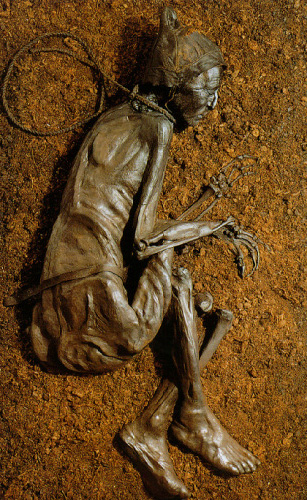
Tollund Man on display at the Silkeborg Museum in Denmark. Only his head was preserved. The body is a replica reconstructed using the bones of the decayed original.
What is certain is the deceased was a man in his late twenties, about 1.68 meters (5 feet, 6 inches) and 60 to 65 kilograms (132 to 143 pounds), strong, well built, and apparently not accustomed to heavy physical work. His nails were manicured and his brown-ginger hair and moustache neatly trimmed. And he was dumped face-first into the bog after his death, roughly between 2 BCE and 119 CE.
Put a mystery in front of any five scientists, and you’ll end up with a lot of arguing and a dozen theories but probably few concrete answers. For Lindow Man that extends to how he died. His body shows evidence of multiple injuries, including a couple of blows to his head with a V-shaped implement, possibly an axe, which appears to have driven a sliver of skull into his brain. A hard blow across his back with something blunt broke his neck and at least one rib. Ligature marks on the neck where a sinew cord was found may indicate garroting. His throat was cut from ear to ear. And he may have been stabbed. The argument centers on which of these happened before he died, which caused his death, what was done to his lifeless body, and what happened to the body over its centuries in the bog that might mimic man-made injuries.
Take the ligature marks. Disagreement continues over whether the cord was used to throttle Lindow Man or to help the blood drain when his throat was cut. Or perhaps the cord was simply a necklace, and the marks occurred as his corpse bloated in the days after his death.
What about the blows to the head? Some researchers have argued the crushing of the skull was caused by the weight of the peat bog, long after he died. But more recent CT scans and xeroradiography (a form of X-ray) have shown evidence of swelling in the brain. This suggests Lindow Man was struck and lay (probably) unconscious for at least a few hours before he died.
So perhaps we know how he died. But why did Lindow Man die?
Atomic absorption spectroscopy shows the skin on Lindow Man’s torso had higher levels of copper than elsewhere on his body. He may have been painted with a copper pigment, suggesting some ritual element to his death.
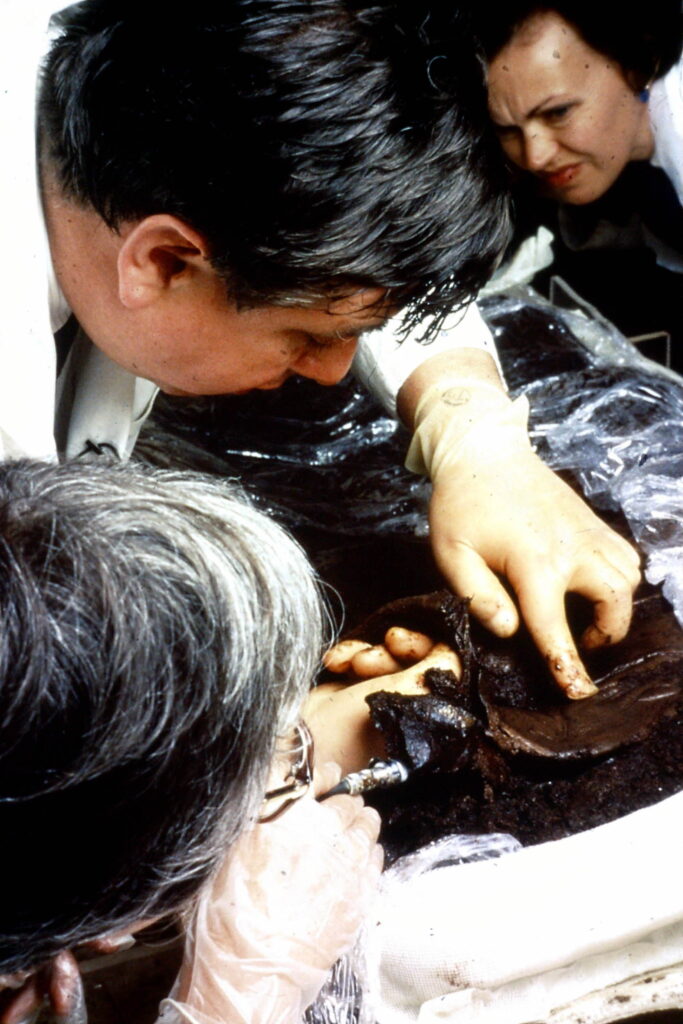
Researchers examine the remains of Lindow Man at the British Museum.
The idea is backed up by scanning electron microscopy results, which found sphagnum moss spores, crushed wheat, bran, barley grains, and mistletoe pollen in his stomach (as well as the eggs of roundworms and whipworms). Mistletoe pollen may have been used in druidic rituals during the late Iron Age and early Roman era in Britain.
One common theory is that Lindow Man was “triple-killed.” Many of the bog bodies found in Europe show a pattern of triplicate injuries, possibly as some form of ritual sacrifice. That’s the view taken by Turner in his book The Lindow Man Phenomenon: Ancient and Modern.
Lindow Man’s stomach contents show he was killed in late winter or early spring. The ancient Celtic festival of Beltane was usually held on May 1 and in times of great danger, such as during the Roman invasion. As part of this ritual a special bread was prepared, and one piece deliberately burned. As portions of the bread were given out, whoever received the burned piece became “the devoted one,” or the sacrifice. The remains of the griddlecake found in Lindow Man’s stomach, with bran and char remnants, might support this theory.
Another theory of ritual sacrifice points to the fact that many bog bodies show distinguishing deformities. Lindow III, found in Lindow Moss in 1987, has a vestigial thumb. The spine of Yde Girl (also found in 1987 near the village of Yde in the Netherlands) was curved with scoliosis. Although not obviously deformed, it is possible Lindow Man was chosen as some form of ritual scapegoat used to absolve collective guilt or fear.
Eamonn Kelly, the former keeper of Irish antiquities at Dublin’s National Museum of Ireland, suggested somewhat controversially that some of these bogs lie at the boundary of ancient territories and that a human sacrifice in such a location could be associated with other Iron Age practices of making sacrifices of objects at tribal boundaries: tools, weapons, cauldrons, and personal ornaments.
Or perhaps Lindow Man was simply the unfortunate victim of a robbery. Robert Connolly of the University of Liverpool takes the view that certain injuries, including the neck wound and broken rib, occurred after the body was removed from the bog. Writing in the journal Anthropology Today in 1985, Connolly argued the broken neck was from a heavy blow and the sinew cord is just a necklace. “Whether he was fighting naked or his clothes have degraded without trace is open to question. If, as is suggested by his hair, nails and bodily habitus, he was more than a simple peasant, then perhaps his clothes were worth taking either by his assailant or some other person or persons unknown; but absence of preserved clothes does not confirm ritual.”
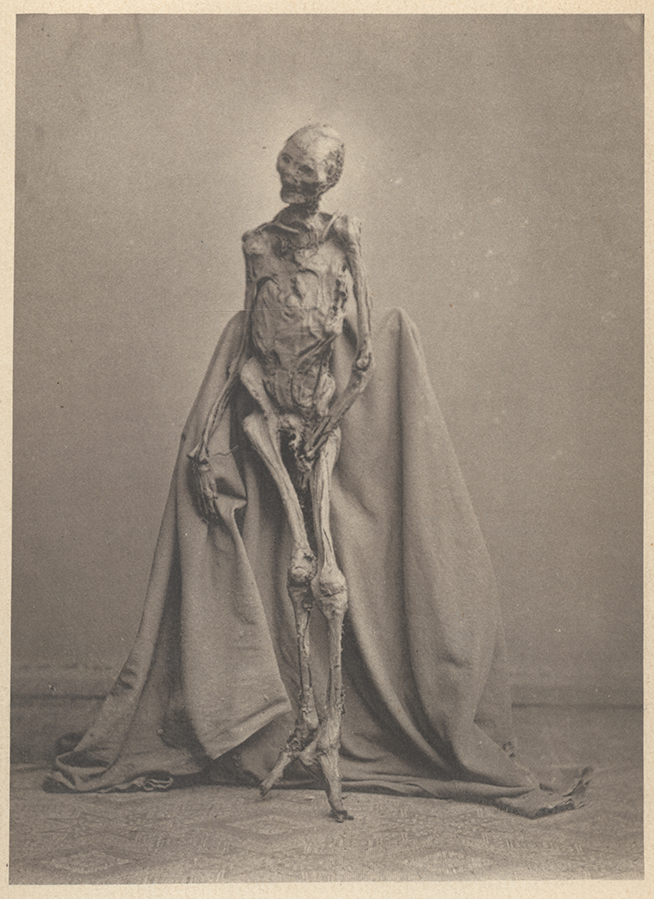
Rendswühren Man, 1873. The remains were smoked in an attempt to preserve them.
That interpretation has fallen by the wayside with more recent data showing Lindow Man being left alive for hours between the bashing of his skull and the slitting of his throat. And really, who wanders the bogs naked while carrying enough worldly goods to warrant a mugging?
Perhaps the killing was a form of punishment. In the 1st century CE, Roman general Tacitus wrote of Germanic tribes that “the coward, the shirker and the disreputable body are drowned in miry swamps under a cover of wattled hurdles.” An earlier author, Diodorus Siculus, wrote in the 1st century BCE that the Gauls used human sacrifice for augury. In his Bibliotheca historica, Diodorus said the Gauls would “kill a man by a knife-stab in the region above the midriff, and after his fall they foretell the future by the convulsions of his limbs and the pouring of his blood.” But we also have to view such accounts with some skepticism. The Romans were neither the first nor the last conquerors who sought to justify their invasion in terms of bringing a civilizing influence to “barbarian” cultures.
The scientific and historical arguments are likely to go on. Improved technologies and new finds will continue to give us fragments of information, tantalizing glimpses of a world long past, but may never get us to the truth behind these deaths. There are missing pieces to the puzzle and more than one way the available pieces can be arranged. These gaps leave us plenty of room to speculate on these ancient people, their final hours, and the reasons for their deaths. As for Lindow Man, he can be viewed at the British Museum. There visitors can consider the arguments and perhaps come to their own conclusions about this ancient mystery.

